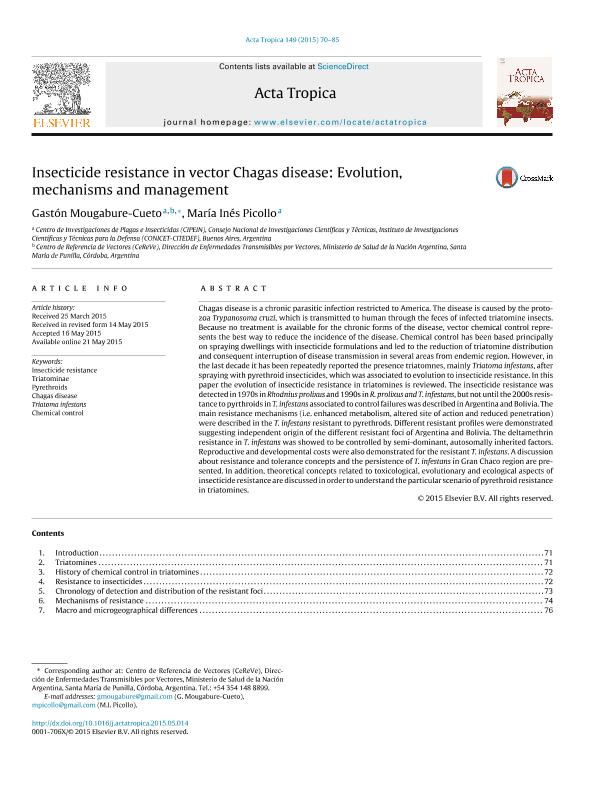Mostrar el registro sencillo del ítem
dc.contributor.author
Mougabure Cueto, Gastón Adolfo

dc.contributor.author
Picollo, Maria Ines

dc.date.available
2018-10-02T18:04:57Z
dc.date.issued
2015-09
dc.identifier.citation
Mougabure Cueto, Gastón Adolfo; Picollo, Maria Ines; Insecticide resistance in vector Chagas disease: Evolution, mechanisms and management; Elsevier Science; Acta Tropica; 149; 9-2015; 70-85
dc.identifier.issn
0001-706X
dc.identifier.uri
http://hdl.handle.net/11336/61521
dc.description.abstract
Chagas disease is a chronic parasitic infection restricted to America. The disease is caused by the protozoa Trypanosoma cruzi, which is transmitted to human through the feces of infected triatomine insects. Because no treatment is available for the chronic forms of the disease, vector chemical control represents the best way to reduce the incidence of the disease. Chemical control has been based principally on spraying dwellings with insecticide formulations and led to the reduction of triatomine distribution and consequent interruption of disease transmission in several areas from endemic region. However, in the last decade it has been repeatedly reported the presence triatomnes, mainly Triatoma infestans, after spraying with pyrethroid insecticides, which was associated to evolution to insecticide resistance. In this paper the evolution of insecticide resistance in triatomines is reviewed. The insecticide resistance was detected in 1970s in Rhodnius prolixus and 1990s in R. prolixus and T. infestans, but not until the 2000s resistance to pyrthroids in T. infestans associated to control failures was described in Argentina and Bolivia. The main resistance mechanisms (i.e. enhanced metabolism, altered site of action and reduced penetration) were described in the T. infestans resistant to pyrethrods. Different resistant profiles were demonstrated suggesting independent origin of the different resistant foci of Argentina and Bolivia. The deltamethrin resistance in T. infestans was showed to be controlled by semi-dominant, autosomally inherited factors. Reproductive and developmental costs were also demonstrated for the resistant T. infestans. A discussion about resistance and tolerance concepts and the persistence of T. infestans in Gran Chaco region are presented. In addition, theoretical concepts related to toxicological, evolutionary and ecological aspects of insecticide resistance are discussed in order to understand the particular scenario of pyrethroid resistance in triatomines.
dc.format
application/pdf
dc.language.iso
eng
dc.publisher
Elsevier Science

dc.rights
info:eu-repo/semantics/openAccess
dc.rights.uri
https://creativecommons.org/licenses/by-nc-nd/2.5/ar/
dc.subject
Chagas Disease
dc.subject
Chemical Control
dc.subject
Insecticide Resistance
dc.subject
Pyrethroids
dc.subject
Triatoma Infestans
dc.subject
Triatominae
dc.subject.classification
Otras Ciencias Biológicas

dc.subject.classification
Ciencias Biológicas

dc.subject.classification
CIENCIAS NATURALES Y EXACTAS

dc.title
Insecticide resistance in vector Chagas disease: Evolution, mechanisms and management
dc.type
info:eu-repo/semantics/article
dc.type
info:ar-repo/semantics/artículo
dc.type
info:eu-repo/semantics/publishedVersion
dc.date.updated
2018-10-01T15:43:57Z
dc.journal.volume
149
dc.journal.pagination
70-85
dc.journal.pais
Países Bajos

dc.journal.ciudad
Amsterdam
dc.description.fil
Fil: Mougabure Cueto, Gastón Adolfo. Ministerio de Salud. Dirección de Enfermedades Transmisibles Por Vectores. Centro de Referencia de Vectores; Argentina. Consejo Nacional de Investigaciones Científicas y Técnicas; Argentina
dc.description.fil
Fil: Picollo, Maria Ines. Ministerio de Defensa. Instituto de Investigaciones Científicas y Técnicas para la Defensa; Argentina. Consejo Nacional de Investigaciones Científicas y Técnicas; Argentina
dc.journal.title
Acta Tropica

dc.relation.alternativeid
info:eu-repo/semantics/altIdentifier/doi/http://dx.doi.org/10.1016/j.actatropica.2015.05.014
dc.relation.alternativeid
info:eu-repo/semantics/altIdentifier/url/https://www.sciencedirect.com/science/article/pii/S0001706X15300073
Archivos asociados
